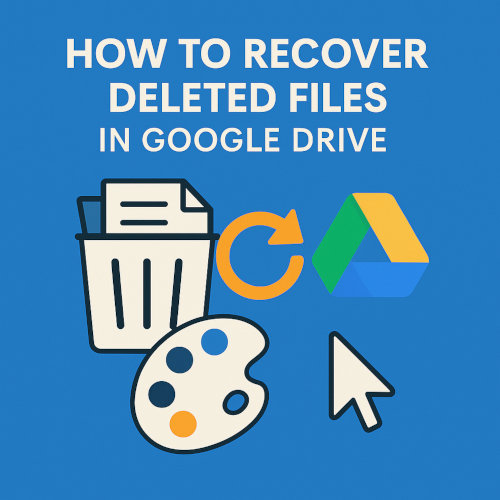How to Recover Deleted Files in Google Drive
Accidentally deleting files in Google Drive can feel like a disaster, especially when they contain important work, personal memories or shared content. Fortunately, Google Drive offers several built-in recovery options to help you retrieve deleted files, whether you're using a personal account or part of a Workspace. In this guide, we'll walk you through the different methods for recovering deleted files, along with tips for avoiding data loss in the future.

1. Check the Trash Folder
Google Drive doesn't permanently delete files right away. When you delete a file, it's moved to the Trash folder (also called "Bin"), where it stays for 30 days before being permanently removed. During that period, you can recover those deleted files from Trash.
To recover files from Trash:
- Open Google Drive.
- On the left panel, click Trash or Bin.
- Right-click the file you want to restore.
- Select Restore.
Right-click → Restore
Note: Files in Trash after 30 days will be automatically and permanently deleted.
2. Use Google Drive Search
Sometimes, files aren't actually deleted, they're just hard to find. Use the search bar at the top of Drive to search by:
- File name
- Keywords in the document
- Owner's name
- File type (e.g., PDF, Sheets, Docs)
Example: type:pdf project report
Click the filter icon in the search bar to refine by file type, location, date modified, and more.
3. Restore Shared Files Deleted by Others
If someone deleted a file that was shared with you, it might no longer appear in your Drive. However, you can still try:
- Checking your Shared with me section in the sidebar
- Asking the file owner to restore it from their Trash
- Requesting a new share link if the file was permanently deleted
4. Recover Files from Google Admin Console - Workspace Users
If you're using Google Workspace (for schools, businesses, etc.), an admin can recover deleted files for up to 25 days after they've been permanently deleted from Trash.
Steps to recover deleted files for Admins:
- Go to the Google Admin Console.
- Click Users, then find and select the user whose file was deleted.
- Click Restore Data.
- Select the date range and click Restore.
Note: This only works within 25 days of permanent deletion.
5. Use Google Vault
Organizations using Google Vault may be able to recover deleted files if they were subject to retention rules. Admins can search and export content even after deletion depending on the Vault settings.
Tip: Vault is generally used in corporate or educational accounts with compliance needs.
6. Recover from Offline or Synced Backups
If you were using Google Drive's desktop client, Drive for Desktop, there's a chance that deleted files still exist locally on your computer:
- Check your computer's Recycle Bin or Trash.
- Look in the Google Drive folder on your system.
- If you use third-party backup software, search there as well.
7. Contact Google Support
If you've exhausted all self-service recovery options, try reaching out to Google Drive Support. In some cases, support agents can help recover recently deleted content even after it's been removed from the Trash.
Steps:
- Go to the Google Drive Help Center.
- Click on Contact Us or Get Help.
- Provide details about the missing file and timeframe.
8. Tips to Prevent File Loss
To avoid future file recovery issues, consider these best practices:
- Regularly back up: Use Drive for Desktop or another cloud service.
- Set up notifications: Use Google Workspace tools to monitor changes.
- Organize your Drive: Use folders and naming conventions.
- Limit delete access: Restrict editing permissions for sensitive files.
Recovering deleted files in Google Drive is often easier than you think—especially if you act quickly. Whether you're working from a personal account or managing a team in Google Workspace, there are several recovery methods at your disposal. Just remember to check the Trash folder first, use search effectively, and contact support if necessary. With these tools and habits, you can safeguard your digital documents and avoid losing critical data.
More Google Tips
How to Use Google Keep for To-Do Lists How to Embed a Google Map on Your Website How to Use Google Translate More Effectively How to Create an API Key in Google Developers Console How to Add Google+ Button to Your Website What is I'm Feeling Lucky Button on Google Used For?
Google Tips